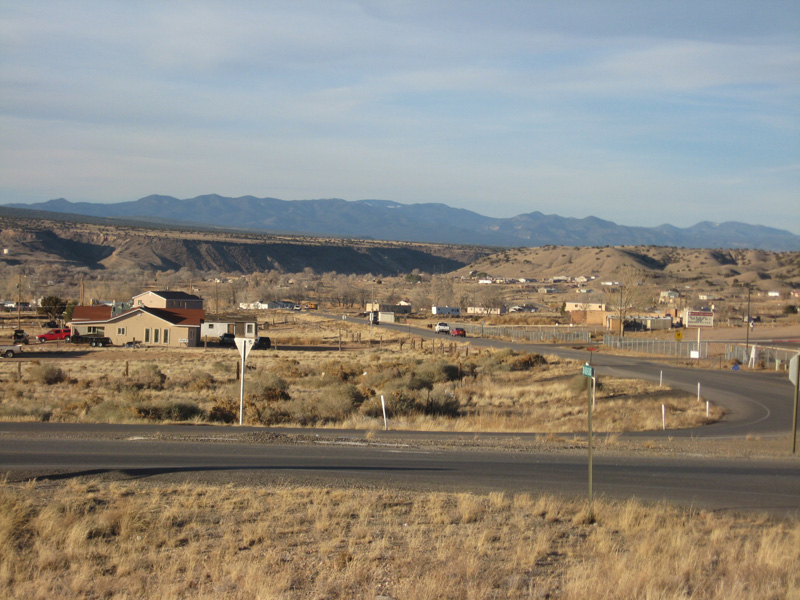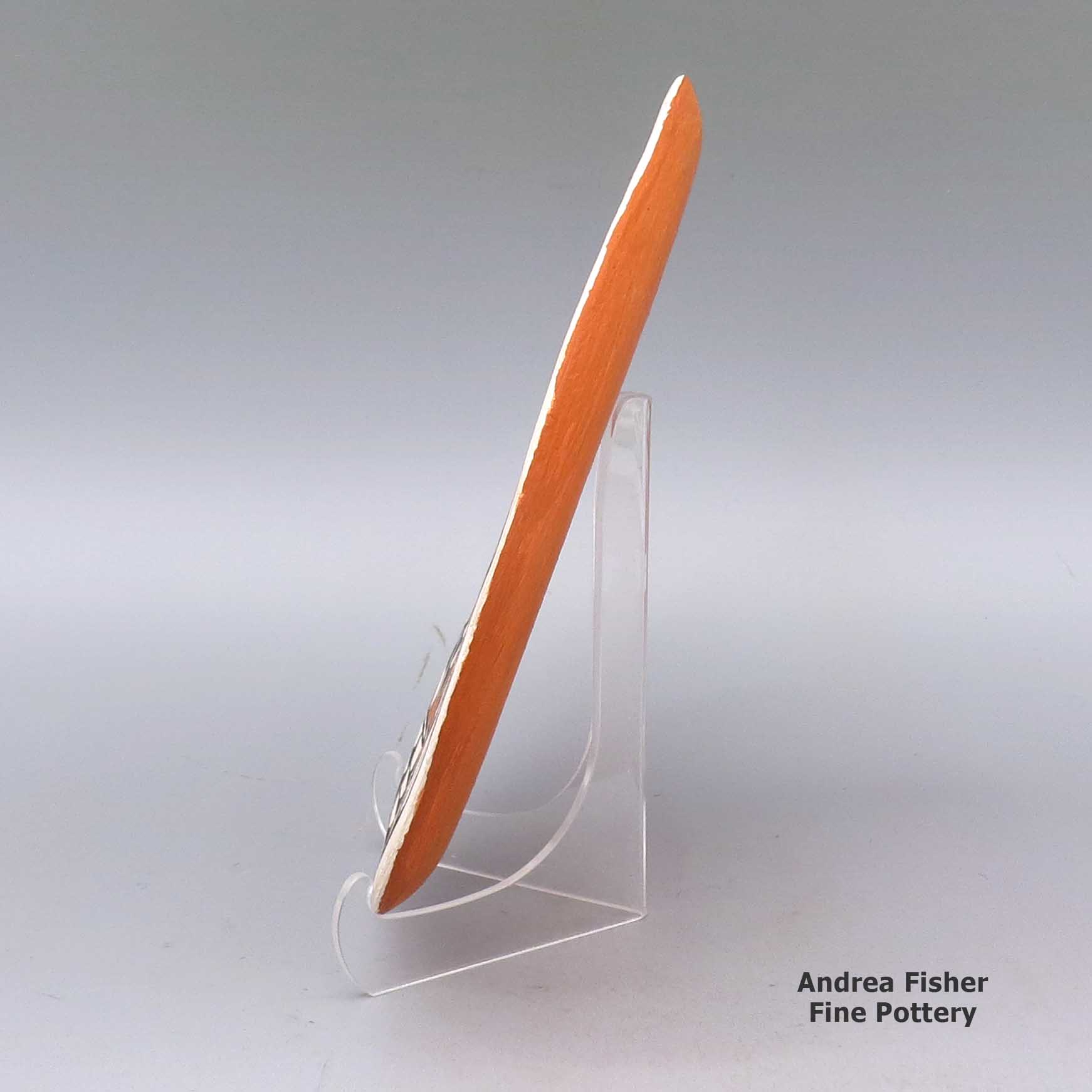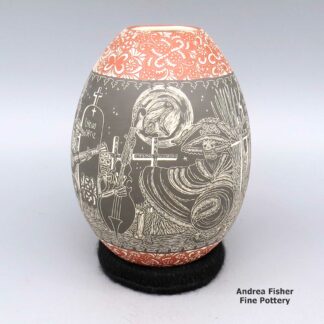| Dimensions | 7 × 7 × 0.5 in |
|---|---|
| Signature | Latoma |
| Date Born | 2007 |
| Condition of Piece | Very good |
Pauline Latoma, plsf2k122, Plate with sun face medallion and geometric design
$175.00
A polychrome plate decorated with a sun face medallion and geometric design
In stock
Brand
Latoma, Pauline
Pauline seems to mostly make polychrome jars decorated with geometric designs common to most of the pueblos.
A Short History of San Felipe Pueblo

During the great migrations from the Four Corners area to what are now the Rio Grande Pueblos, the people of Cochiti, Santo Domingo and San Felipe were one. Before descending off the Pajarito Plateau to the Rio Grande, they settled in the area now known as Bandelier National Monument, taking advantage of a volcanic ash landscape that made it easy to construct dwellings. However, over time that area got too dry, too, and the people decided to move closer to the large river. Disagreements over where to settle split the people into what are now the Cochiti, Santo Domingo and San Felipe Pueblos.

When Francisco de Coronado arrived in 1540, there were two San Felipe villages, one on either side of the Rio Grande. The main villages were comprised of large two-and-three-story structures plus a couple hundred outlying dwellings. Coronado didn't stay long, there was no gold to be had. He and his men quickly moved on to Pecos Pueblo.
San Felipe was left alone until Don Juan de Oñaté came north in 1598. Then the troubles began. The Spanish built their first mission church next to the east village around 1600. It was built with conscript Indian labor and paid for by taxes extracted from the village. As more Spanish settlers moved into the area, that situation got worse.
The people of San Felipe participated in the Pueblo Revolt of 1680 but killed no Spaniards or any priests. Governor Otermin returned with troops in 1681 and found San Felipe abandoned as the people had hidden themselves atop nearby Horn Mesa. The Spaniards looted and burned the pueblo before returning to Mexico. When Don Diego de Vargas came back in 1692, the people chose to surrender and be baptized rather than fight. To test the peace they first settled atop nearby Santa Ana Mesa. A few years later they descended into the Rio Grande Valley and founded today's pueblo.
The Atchison, Topeka and Santa Fe Railroad built their main line along the Rio Grande, crossing Santo Domingo, San Felipe, Santa Ana, Sandia and Isleta land before reaching the Belen Cutoff area in the 1880s. Stations were built along the line next to each of those pueblos. That would have brought tourists to San Felipe but that was discouraged by the elders and there wasn't much to see anyway. Today's AmTrak and New Mexico RailRunner follow some of those same tracks.

For more info:
Pueblos of the Rio Grande, Daniel Gibson, ISBN-13:978-1-887896-26-9, Rio Nuevo Publishers, 2001
About Plates
All potters agree: plates are some of the hardest pieces to make successfully, because they warp and crack very easily when they are drying and during the firing. The potter really has to know their clay and their temper. The only pieces that are harder to make are tiles, for the same reasons. That's why most tiles are smaller than most plates.
Plates appeared after the advent of colonialism in New Mexico. Prior to selling new Spanish and Mexican settlers the plates, pots, cups, jars and other utensils they wanted, most Native Americans in the Southwest used jars for cooking and bowls for serving the food. They also made the ladles and spoons they needed for cooking and eating. New customers required new products.
About Geometric Designs
"Geometric design" is a catch-all term. Yes, we use it to denote some kind of geometric design but that can include everything from symbols, icons and designs from ancient rock art to lace and calico patterns imported by early European pioneers to geometric patterns from digital computer art. In some pueblos, the symbols and patterns denoting mountains, forest, wildlife, birds and other elements sometimes look more like computer art that has little-to-no resemblance to what we have been told they symbolize. Some are built-up layers of patterns, too, each with its own meaning.
"Checkerboard" is a geometric design but a simple black-and-white checkerboard can be interpreted as clouds or stars in the sky, a stormy night, falling rain or snow, corn in the field, kernels of corn on the cob and a host of other things. It all depends on the context it is used in, and it can have several meanings in that context at the same time. Depending on how the colored squares are filled in, various basket weave patterns can easily be made, too.
"Cuadrillos" is a term from Mata Ortiz. It denotes a checkerboard-like design using tiny squares filled in with paints to construct larger patterns.
"Kiva step" is a stepped geometric design pattern denoting a path into the spiritual dimension of the kiva. "Spiral mesa" is a similar pattern, although easily interpreted with other meanings, too. The Dineh have a similar "cloud terrace" pattern.
That said, "geometric designs" proliferated on Puebloan pottery after the Spanish, Mexican and American settlers arrived with their European-made (or influenced) fabrics and ceramics. The newcomers' dinner dishes and printed fabrics contributed much material to the pueblo potters design palette, so much and for so long that many of those imported designs and patterns are considered "traditional" now.





